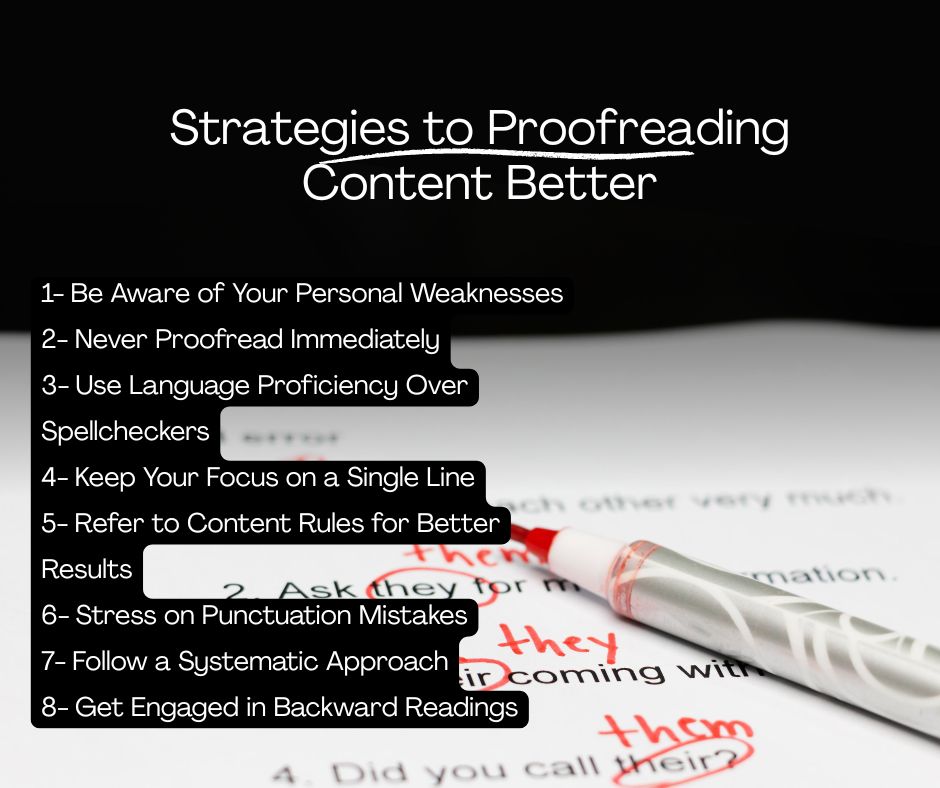Summary – Proofreading is often considered a laborious task in the content writing activity. Learn how to apply these 8 tips and make content proofreading much faster and much more effective.
Reading time – 4 mins
Who is it for – Content writing agencies, content marketing agencies, digital marketing companies, SEO firms.
Writing clearly and precisely has always been a top-most concern for web content writers. For this, it is important to be effective when doing proofreading for a content asset. With the advent of AI in 2025, content proofreading is the key that will help you thrive in a competitive domain.
Carrying out the proofreading process can help you avoid such embarrassment. It can also help you build a strong reputation in front of your regular visitors.
If you wish to enhance your proofreading skills, read the section below to have a good command over your write-ups –
What Is Proofreading and Why Does It Matter?
Before we jump into the tips, let us talk about what proofreading really means. Proofreading is the final check you do on your writing to catch any mistakes before you share it with the world. It is different from editing because you are not changing big ideas or moving paragraphs around. You are just looking for small errors that could make your writing look unprofessional.
Why is Content Proofreading Important?
Think of proofreading as giving your vehicle a final wash before a big day. Your car runs fine, but those little water spots and dust particles can make a bad first impression. The same thing happens with your writing- even great ideas can look sloppy if there are spelling mistakes and grammar errors scattered throughout.
Good proofreading does more than just catch mistakes. It makes your writing easier to read and helps people trust what you’re saying. When readers see clean, error-free writing, they are more likely to stick around and take your message seriously.
Who Benefits from Proofreading?
Pretty much everyone who writes anything can benefit from good proofreading skills. From one-line emails to 20,000 page ebooks, everyone needs polished content to shine through. But some people benefit much more with these skills and succeed in their work and personal lives.
1- Business professionals
They use proofreading daily for:
-emails,
-reports,
-presentations, and
-proposals.
One typo in an important email to your boss could make you look careless. Also, a proposal with grammar errors might lose you a big client because it does not look professional.
2- Content creators and bloggers
Creators depend on polished writing for:
-blogs and articles,
-video scripts,
-web copywriting, and
-social media posts
Content proofreading lets them build their audience effectively. Readers notice when your blog posts have lots of mistakes, and they might not come back. Good proofreading helps you build trust with your users. It also keeps them engaged.
3- Small business owners
They need proofreading for:
-websites,
-social media posts,
-stakeholder and investor reports, and
-customer communications.
Your online site is the initial thing prospective clients see. If it has spelling errors, they might think your business isn’t professional or trustworthy.
4- Students at all levels
Students need proofreading skills for:
-essays,
-college applications, and
-research papers.
A college application with spelling errors can hurt your chances of getting accepted. Research papers with grammar mistakes can cost you points, even if your ideas are brilliant.
5- Authors and freelance writers
They make their living with words, so proofreading is absolutely essential. Editors and publishers expect clean manuscripts. Clients expect error-free content. As a result, your reputation depends on delivering polished work every time.
6- Job seekers
People searching for jobs need proofreading for:
-resumes,
-cover letters, and
-initial and follow-up emails.
Hiring managers often throw out resumes with spelling errors because they show a lack of attention to detail. A well-proofread application shows that you are careful and professional.
How Psychology Affects Content Proofreading?
Understanding how your brain works during proofreading can help you become more effective and efficient.
1- Your Brain Sees What It Expects
Your brain wants to see what it expects to see, not necessarily what is actually on the page. This is why you miss errors in your own writing more often than in other people’s work. Your brain remembers the thing you meant to write. So, it fills in the words on its own.
2- Tiredness Makes Everything Worse
Being tired makes everything worse when it comes to proofreading. When you are exhausted, you miss more errors and work more slowly. You need to do your most important proofreading when you are fresh.
3- Change Your Location
Changing where you work can help reset your attention. If you always write at your desk, try proofreading in a different room or at a coffee shop. The change of scenery can help you see your work with fresh eyes.
4- Take Break Before Starting Content Proofreading
Taking breaks is not just nice- it is necessary for good proofreading. Your attention span is limited. Writing through tiredness can result in more errors. Even a 5 minute break can bring your focus back.
What are the Strategies in Content Proofreading?
1- Be Aware of Your Personal Weaknesses
Most of the writers may spell the same words incorrectly multiple times, increasing the chances of making spelling errors more frequently. Some typing flaws and the habit of using incorrect key combinations may end up increasing the chances of making big mistakes in your write-up.
If you’re aware of your weaknesses, then keep a check on the same and be extra attentive to proofread your write-ups efficiently.
2- Never Proofread Immediately
It is better to proofread a completed draft after a few minutes or hours instead of proofreading your write-ups immediately. Proofreading long content pieces with a fresh mind can assist in detecting errors and flaws at a faster pace. A better option would be to let another person do the proofreading.
3- Use Language Proficiency Over Spellcheckers
Use your language proficiency and catch spelling mistakes before you publish the content on the web to build a strong reputation as a writer. Always have a fresh and objective look while proofreading to guarantee perfection.
This holds true for the dreaded American vs British English dilemma that writers usually face
4- Keep Your Focus on a Single Line
Never read the whole paragraph at once, as it may ruin the entire picture and end up skipping the crucial mistakes. The best solution to avoid the same is- focusing on a single line or evaluating each sentence wholly for:
-sentence construction,
-structure, and
-punctuation mistakes.
Let us see how much time you should spend on a single line and what mistakes you should commonly search for.
| Systematic Line-by-Line Proofreading Approach | |||
| Step | What to Look For | Time Required | Common Mistakes Found |
| 1 | Read sentence aloud | 30 seconds per sentence | Awkward phrasing, missing words |
| 2 | Check punctuation | 15 seconds per sentence | Missing commas, incorrect periods |
| 3 | Verify spelling | 20 seconds per sentence | Typos, wrong word usage |
| 4 | Confirm grammar | 25 seconds per sentence | Subject-verb agreement, tense issues |
| 5 | Review sentence flow | 20 seconds per sentence | Choppy transitions, unclear meaning |
5- Refer to Content Rules for Better Results
One of the key factors that can help you identify mistakes easily is the content rule book. Keep a handbook of style handy for immediate reference, and make the most out of your proofreading sessions.
Referring to the universal writing style may consume more time and effort, but it helps in improving the speed and accuracy of writing.
6- Stress on Punctuation Mistakes
Being a professional writer, you may write everything clearly and accurately, but sometimes, minute punctuation errors might ruin the entire hard work.
The best solution to avoid punctuation errors is- to take a printout of your written content and circle the punctuation mistakes, including every comma, period, semicolon, colon, and others, to make your write-up fit for accuracy evaluation. Correct the spotted mistakes in the final copy and publish the same.
7- Follow a Systematic Approach
It would be highly appreciable if you could follow a systematic approach to proofreading your written content. Using the same approach for every write-up may make you efficient in spotting spelling and grammar errors with great ease.
Additionally, you must identify unclear statements and poor grammar, rework them, and then proofread the final copy to ensure that only high-quality content gets published for reading.
8- Get Engaged in Backward Readings
Sometimes, reading with the flow may make your mind think in a particular direction, disabling you to fill in non-existent letters, required words, and necessary punctuation.
To bring the change, you must read through the text backward and anticipate the rhythm & flow of the writing. Focus on the words, vocabulary, and letters to identify the mistakes and correct them before publishing.

Common Proofreading Mistakes to Avoid
Even good writers make mistakes when proofreading. Here are the biggest traps that slow you down and cause you to overlook writing mistakes.
1- Do Not Rush the Process
This is the biggest mistake people make. When you are in a hurry, your brain fills in missing words and skips over errors. So, take your time, even if it means starting your proofreading earlier.
2- Do Not Trust Spell Check Too Much
A spell check gives you false confidence. It won’t catch words that are spelled right but used wrong, like “their” instead of “there.” It also misses many grammar problems and punctuation errors.
3- Do Not Skip Reading Out Loud in Content Proofreading
You will miss sentences that sound awkward or confusing when you read silently. This is because your brain automatically fixes problems. Meanwhile, reading aloud forces you to hear all the words and pauses.
5- Do Not Jump from Writing to Proofreading
This does not give your brain time to reset. You need take some time of your work. This will help you see it clearly. Even a 10-minute break can make a big difference.
Tools That Make Proofreading Faster
Your own skills matter most, but some tools can help you work faster and catch more mistakes.
1- Grammar Checking Software
Tools like Grammarly or Hemingway Editor can catch many basic errors and suggest improvements. These tools are getting better all the time, but they are not perfect. You can use them as a first step, not a replacement for careful human proofreading.
2- Text-to-Speech Software
This software can read your writing back to you, which helps catch mistakes you might miss when reading silently. Most computers and phones have built-in text-to-speech features, or you can find free apps online.
3- Style Guides and Dictionaries
Keep these within reach. Whether you prefer online resources like Merriam-Webster or physical books, having reliable references saves time when you are unsure about spelling, usage, or style rules.
4- Content Proofreading Checklists
These lists can help you check for different types of errors. It can help if you create your own based on the mistakes you make most often. You can also search for templates online that you can customize.
Here is a sample proofreading checklist that you can use:
| Blog & Web Content Proofreading Checklist | ||
| Category | Checklist Item | Done? |
| Grammar & Spelling | Check for subject-verb agreement and tense consistency. | ⃝ |
| Verify homophones (their/there, its/it’s). | ⃝ | |
| Run spell-check but manually review (tools miss context errors). | ⃝ | |
| Review proper nouns and technical terms. | ⃝ | |
| Punctuation | Confirm commas, periods, and semicolons are correct. | ⃝ |
| Check apostrophes and quotation marks. | ⃝ | |
| Fix hyphen/dash misuse (e.g., “well-known” vs. “well known”). | ⃝ | |
| Clarity & Flow | Read aloud for awkward phrasing or missing words. | ⃝ |
| Ensure smooth transitions between paragraphs. | ⃝ | |
| Remove redundant phrases (e.g., “in order to” → “to”). | ⃝ | |
| Formatting | Headings are consistent (H1, H2, etc.). | ⃝ |
| Bullet points and lists are properly formatted. | ⃝ | |
| No orphaned words or broken layouts. | ⃝ | |
| SEO & Technical | Meta description ≤160 chars with keywords. | ⃝ |
| Alt text for images is descriptive. | ⃝ | |
| Internal/external links work correctly. | ⃝ | |
| Consistency | Tone matches brand voice (formal/casual). | ⃝ |
| Capitalization uniform (e.g., product names). | ⃝ | |
| Date/currency formats consistent (e.g., “June 8, 2025”). | ⃝ | |
| Final Checks | Printed copy reviewed (if possible). | ⃝ |
| Read backward to catch spelling errors. | ⃝ | |
| Took a break (≥10 mins) before final proofread. | ⃝ | |
| Second reviewer checked (if available). | ⃝ | |
5- Team Collaboration Tools
Tools like Google Docs or Microsoft Word track changes. This feature makes it easier to get feedback from others and keep track of corrections. These tools are especially helpful when working with editors or team members.
How to Build Speed in Content Proofreading Without Missing Errors
The goal is not just to proofread faster- it is to proofread well while still catching all the important errors. Here is how to build speed over time.
| Summary Table: Building Speed in Proofreading Without Missing Errors | ||
| Strategy | Key Actions | Benefits |
| Practice Regularly | Proofread diverse content (articles, blogs, old drafts). | Improves error-spotting speed and accuracy over time. |
| Build Muscle Memory | Track and memorize common mistakes (e.g., typos, grammar weak spots). | Faster recognition and correction of repetitive errors. |
| Use Keyboard Shortcuts | Master shortcuts for spell-check, find/replace, and formatting. | Saves time during corrections. |
| Set Time Limits | Start with generous deadlines, then gradually reduce them. | Enhances focus and prevents perfectionism slowing you down. |
| Focus on Big Errors First | Prioritize spelling, grammar, and clarity over minor style tweaks. | Ensures critical errors are fixed when time is limited. |
1- Practice Regularly
Practice with different types of writing. The more you proofread, the faster you will get at spotting common problems. Try proofreading newspaper articles, blog posts, or even your own old writing to build your skills.
2- Build Muscle Memory for Common Fixes
When you see the same types of errors over and over, your brain learns to spot them quickly. This is why keeping track of your personal weaknesses is so important.
3- Use Keyboard Shortcuts
You need to learn the keyboard shortcuts in your word processor to make corrections faster. It can help if you master shortcuts for common tasks like find-and-replace, spell-check, and formatting changes.
4- Set Time Limits for Content Proofreading
Having a deadline keeps you focused and prevents perfectionism from slowing you down. Start with generous time limits. Then, gradually reduce them as you improve.
5- Focus on Big Errors First
When time is limited, spelling mistakes and obvious grammar errors are more important than minor style preferences. It is important to know which battles to fight and which ones to let go.
Special Strategies for Different Types of Content Assets
Some types of writing need special proofreading approaches because they are longer, more technical, or have special formatting requirements.
1- Academic Papers and Research
For academic papers and research, pay extra attention to citations, footnotes, and bibliography formatting. These elements are easy to mess up and hard to fix if you wait until the last minute.
2- Business Documents
For business documents, focus on tone and professionalism as well as technical accuracy. Make sure your writing sounds right for your audience and company culture.
3- Web Content
For web content, remember that people read differently online. Short paragraphs, bullet points, and headers are more important than they would be in print. Also check that links work and images show up correctly.
4- Creative Writing
For creative writing, balance technical correctness with keeping your unique voice and style. Do not let perfect grammar rules override what sounds natural for your characters or story style.
Wrapping Up
Following these tips can help you cut your content proofreading time from hours to minutes. Sure, the process can feel tiring and frustrating, but it is really important to make sure your readers get a good impression and keep coming back to your blog or website.
It is important that you focus on your weak spots and look for ways to improve. This will ensure your writing is error-free. It will also boost your success.
Remember that becoming a fast, effective proofreader takes time and practice. Do not expect to master all these techniques overnight. It can help if you start with one or two strategies that seem most helpful for your situation and gradually add more as they become habits.
The team at Textuar will help you with high-quality proofreading services that amplifies that your brand messaging. Contact us today itself.
Content Proofreading – Frequently Asked Questions
Q- How long should I wait between writing and proofreading?
You need to give at least 10-15 minutes for short pieces and several hours or overnight for important documents. This break will help you check your work with fresh eyes. It will also help you catch errors you would otherwise miss because your brain is too familiar with what you meant to write.
Q- Should I proofread on paper or on screen?
Both have benefits, but many people catch more errors on paper. The physical format change tricks your brain into seeing text differently. However, screen proofreading is faster for making corrections. It can help if you try alternating between both methods for the best results.
Q- Is proofreading and editing the same?
Editing focuses on big-picture issues like structure and clarity. Proofreading is the final step. It catches small errors like spelling and grammar. Always edit first, then proofread. Trying to do both at once makes you less effective at each task.
Q- How can I catch my own repeated mistakes?
You need to keep a personal error log for a few weeks. Write down every mistake you find in your writing. You will start seeing patterns- maybe you always confuse “its” and “it’s” or forget commas in certain places. Once you know your weak spots, you can look for them specifically.









